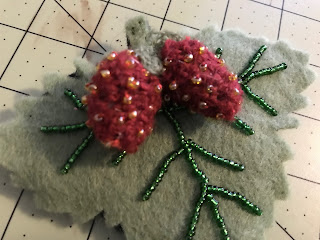This was quite a new concept for me as by the 1850s, we had gummed envelopes so wax and wafers were old fashioned by my usual time period. But delving nearly 20 years prior, I've had to pick up some new skills along the way.
 |
| Back of a letter written by my living history character, Sarah Wharton Yale University Archives |
On the back of Mrs. Wharton's letter, you can see remnants of a seal. The actual seal is missing (I believe it was on the chewed away parts) so we can't actually see what her seal was. But I CAN tell you Sarah used red sealing wax!
The first step was to order a custom seal for Sarah. I chose a simple SW for her initials. Looking at original seals, initials seem to be popular for 1820-1840. Some had the first, middle, and last initial; but I chose just first and last 1) because 2 letters fit on the seal better than 3 and 2) her initials spell SAW and I didn't want there to be any confusion that it represented initials not a word. And since we can't see Sarah's actual seal, it could have been almost anything.
Now Sarah was wealthy and therefore probably had a fancy seal. Possible precious metal and stone or more likely ivory or bone. I did wood because that was what I could get. I decided that since this isn't Sarah's 'real' seal but rather one that sits with her traveling port folio, she may not have spent the extra money on something that could have gotten misplaced on all her travels. Therefore, I decided cheaper was okay for this project.
I ordered a seal from Etsy that works just fine.
Then I set about making some sealing wax. I didn't necessarily have to as you can still buy sealing wax today, but I thought it would be fun making my own even though Sarah most definitely would not.
My sealing wax receipt comes from Edward Somerset's 1822 publication of "A thousand notable things, embracing a collection of scarce receipts".
I used olive oil instead of turpentine but otherwise followed the receipt as far as main ingredients. Of course, vermillion is poisonous and otherwise unavailable should I even want to use it so I used red mica powder instead. This first batch turned out rather transparent so next time I will add more colorant.
I also chose to make other colors, as described in "The Cyclopaedia; Or, Universal Dictionary of Arts, Sciences and Literature" published in 1819 by Abraham Rees.
I did not make purple but did attempt black, green, blue, and yellow. I used my own colorants that I already had, although I know I can get verdigrise for green next time. This go around, I used terre verde from earthpigments.com for green, brilliant yellow of the same company for yellow, blue mica powder for the blue, and black mica powder for the black.
I couldn't get the isinglass to dissolve so I had to forgo that. I also took out the yeast because I had a hard time getting them thin enough without leavening. There are other receipts that only call for flour, water, and colorant so I didn't feel bad leaving it out.
Next time, I'll try Brazilwood for read, indigo for blue (I tried but I couldn't quite figure it out yet. I'm working on it),and probably turmeric for yellow (I didn't have any in my pantry at the time). Food coloring will work for now. These are still experiments.
The wafers are still quite thick as you can see. I'm working on thinning them down as the originals that are seen are nearly paper thin.
But I'm still happy with how the whole project came out!




























